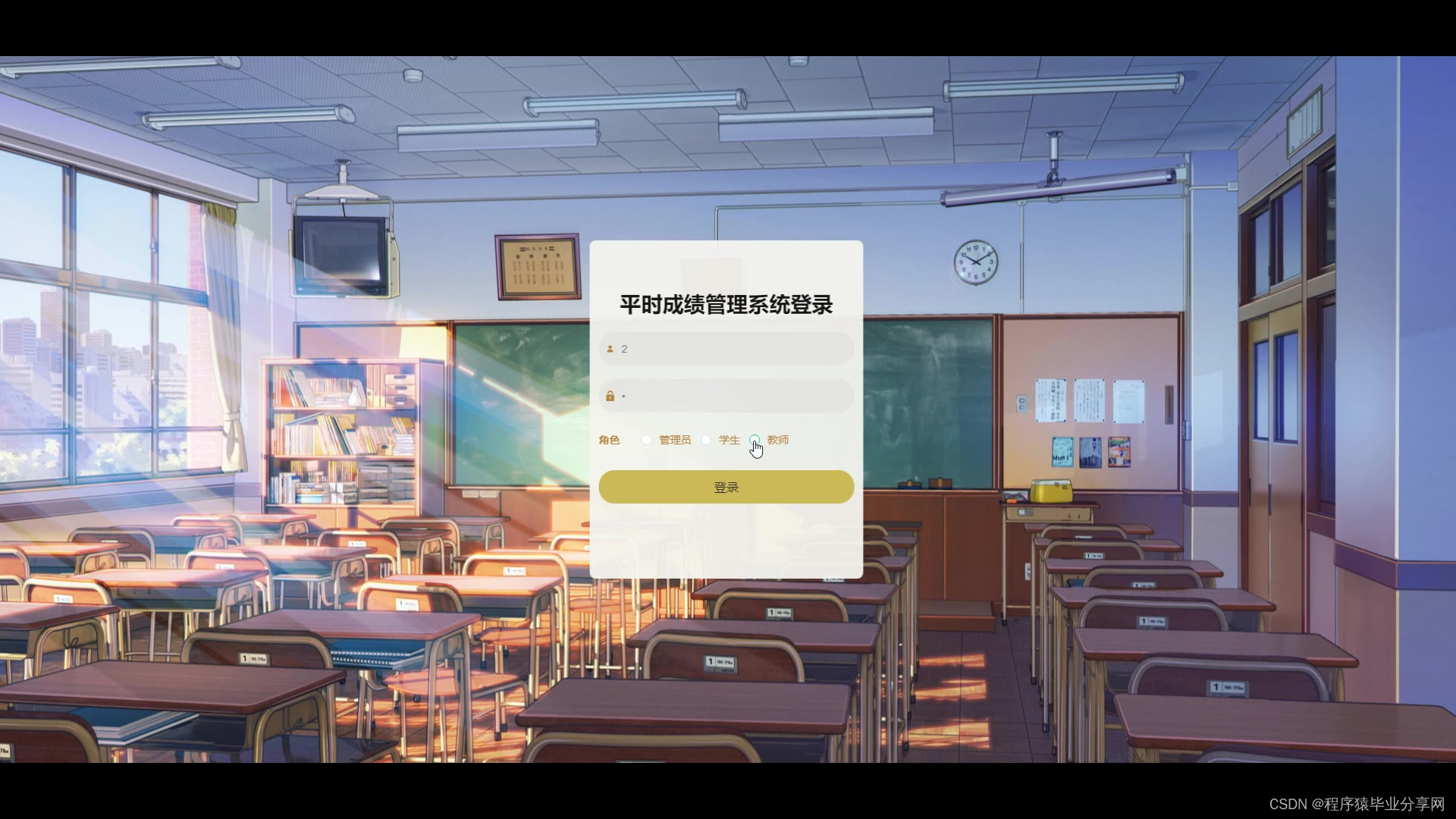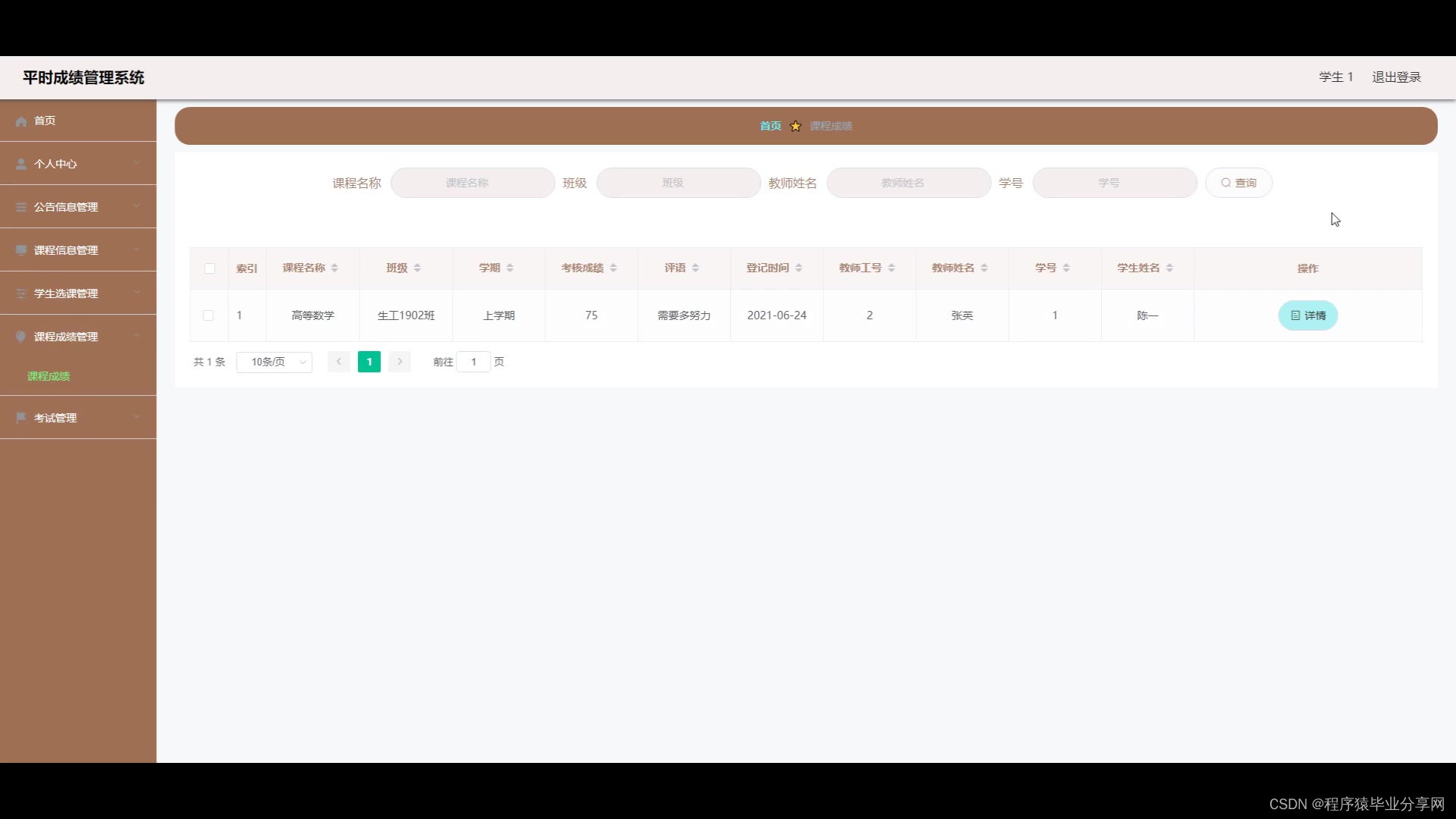基于Java的ssm平时成绩管理系统源码和论文149
开发工具:idea 或eclipse
数据库mysql5.7+
数据库链接工具:navcat,小海豚等
技术:ssm
摘 要
高校人才培养计划的重要组成部分,是实现人才培养目标、培养学生科研能力与创新思维、检验学生综合素质与实践能力的重要手段与综合性实践教学环节。而我所在学院多采用线下教育教学的方式,所以有必要开发平时成绩管理系统来对教学档案进行数字化管理。既可减轻学院教职员工工作压力,比较系统地对教务、教学上的各项服务和信息进行管理,又可加快成绩查询速度、加强成绩管理,跟上国家各部门关于信息化的步伐,使各项管理更加规范化。 正是针对上述问题,本论文对平时成绩管理系统的开发过程进行了较为详细的论述,ssm 框架和 java 开发的 Web 框架, eclipse开发工具。
平时成绩管理系统,主要的模块包括管理员;首页、个人中心、公告信息管理、班级管理、学生管理、教师管理、课程信息管理、学生选课管理、课程成绩管理、试题管理、试卷管理、考试管理,学生;首页、个人中心、公告信息管理、课程信息管理、学生选课管理、课程成绩管理、考试管理;教师;首页、个人中心、公告信息管理、课程信息管理、学生选课管理、课程成绩管理、试题管理、试卷管理、考试管理等功能。系统中管理员主要是为了安全有效地存储和管理各类信息,还可以对系统进行管理与更新维护等操作,并且对后台有相应的操作权限。
要想实现平时成绩管理系统的各项功能,需要后台数据库的大力支持。管理员验证注册信息,收集的用户信息,并由此分析得出的关联信息等大量的数据都由数据库管理。本文中数据库服务器端采用了Mysql作为后台数据库,使Web与数据库紧密联系起来。在设计过程中,充分保证了系统代码的良好可读性、实用性、易扩展性、通用性、便于后期维护、操作方便以及页面简洁等特点。
本系统的开发使获取平时成绩管理系统信息能够更加方便快捷,同时也使平时成绩管理系统信息变的更加系统化、有序化。系统界面较友好,易于操作。
关键词:平时成绩管理系统 ;java技术 ;Mysql数据库; ssm框架
Abstract
As an important part of the talent training plan in Colleges and universities, it is an important means and comprehensive practical teaching link to achieve the goal of talent training, cultivate students' scientific research ability and innovative thinking, and test students' comprehensive quality and practical ability. And my college mostly adopts the way of offline education and teaching, so it is necessary to develop the usual performance management system to carry out digital management of teaching archives. It can not only reduce the work pressure of the faculty and staff, but also systematically manage the various services and information of educational administration and teaching, accelerate the speed of score inquiry, strengthen the score management, keep up with the pace of informatization of various departments of the state, and make the management more standardized. In view of the above problems, this paper discusses the development process of usual performance management system in detail, including SSM framework, web framework developed by Java and eclipse development tool.
Peacetime performance management system, the main modules include administrator; home, personal center, announcement information management, class management, student management, teacher management, course information management, student course selection management, course performance management, test management, paper management, examination management, student; home, personal center, announcement information management, course information management, student course selection management It has the following functions: Science, course performance management, examination management; teacher; home page, personal center, announcement information management, course information management, student course selection management, course performance management, test paper management, examination management, etc. The administrator in the system is mainly for the safe and effective storage and management of all kinds of information, can also manage and update the system maintenance and other operations, and has the corresponding operation authority on the background.
In order to realize the functions of the usual performance management system, it needs the strong support of the background database. The administrator verifies the registration information, collects the user information, and obtains the association information and so on massive data by the database management. In this paper, the database server uses MySQL as the background database, so that the web and database are closely linked. In the design process, it fully ensures the good readability, practicability, expansibility, universality, easy to maintain, easy to operate and concise page of the system code.
The development of the system makes it more convenient to obtain the information of the usual performance management system, and also makes the information of the usual performance management system more systematic and orderly. The system interface is friendly and easy to operate.
Key words: usual performance management system; Java technology; MySQL database; SSM framework


























package com.controller;
import java.text.SimpleDateFormat;
import java.util.ArrayList;
import java.util.Arrays;
import java.util.Calendar;
import java.util.Map;
import java.util.HashMap;
import java.util.Iterator;
import java.util.Date;
import java.util.List;
import javax.servlet.http.HttpServletRequest;
import com.utils.ValidatorUtils;
import org.apache.commons.lang3.StringUtils;
import org.springframework.beans.factory.annotation.Autowired;
import org.springframework.format.annotation.DateTimeFormat;
import org.springframework.web.bind.annotation.PathVariable;
import org.springframework.web.bind.annotation.RequestBody;
import org.springframework.web.bind.annotation.RequestMapping;
import org.springframework.web.bind.annotation.RequestParam;
import org.springframework.web.bind.annotation.RestController;
import com.baomidou.mybatisplus.mapper.EntityWrapper;
import com.baomidou.mybatisplus.mapper.Wrapper;
import com.annotation.IgnoreAuth;
import com.entity.ExamrecordEntity;
import com.entity.view.ExamrecordView;
import com.service.ExamrecordService;
import com.service.TokenService;
import com.utils.PageUtils;
import com.utils.R;
import com.utils.MD5Util;
import com.utils.MPUtil;
import com.utils.CommonUtil;
/**
* 考试记录表
* 后端接口
* @author
* @email
* @date 2021-03-30 11:42:10
*/
@RestController
@RequestMapping("/examrecord")
public class ExamrecordController {
@Autowired
private ExamrecordService examrecordService;
/**
* 考试记录接口
*/
@RequestMapping("/groupby")
public R page2(@RequestParam Map<String, Object> params,ExamrecordEntity examrecord, HttpServletRequest request){
if(!request.getSession().getAttribute("role").toString().equals("管理员")) {
examrecord.setUserid((Long)request.getSession().getAttribute("userId"));
}
EntityWrapper<ExamrecordEntity> ew = new EntityWrapper<ExamrecordEntity>();
PageUtils page = examrecordService.queryPageGroupBy(params, MPUtil.sort(MPUtil.between(MPUtil.likeOrEq(ew, examrecord), params), params));
return R.ok().put("data", page);
}
/**
* 后端列表
*/
@RequestMapping("/page")
public R page(@RequestParam Map<String, Object> params,ExamrecordEntity examrecord,
HttpServletRequest request){
if(!request.getSession().getAttribute("role").toString().equals("管理员")) {
examrecord.setUserid((Long)request.getSession().getAttribute("userId"));
}
EntityWrapper<ExamrecordEntity> ew = new EntityWrapper<ExamrecordEntity>();
PageUtils page = examrecordService.queryPage(params, MPUtil.sort(MPUtil.between(MPUtil.likeOrEq(ew, examrecord), params), params));
return R.ok().put("data", page);
}
/**
* 前端列表
*/
@RequestMapping("/list")
public R list(@RequestParam Map<String, Object> params,ExamrecordEntity examrecord, HttpServletRequest request){
if(!request.getSession().getAttribute("role").toString().equals("管理员")) {
examrecord.setUserid((Long)request.getSession().getAttribute("userId"));
}
EntityWrapper<ExamrecordEntity> ew = new EntityWrapper<ExamrecordEntity>();
PageUtils page = examrecordService.queryPage(params, MPUtil.sort(MPUtil.between(MPUtil.likeOrEq(ew, examrecord), params), params));
return R.ok().put("data", page);
}
/**
* 列表
*/
@RequestMapping("/lists")
public R list( ExamrecordEntity examrecord){
EntityWrapper<ExamrecordEntity> ew = new EntityWrapper<ExamrecordEntity>();
ew.allEq(MPUtil.allEQMapPre( examrecord, "examrecord"));
return R.ok().put("data", examrecordService.selectListView(ew));
}
/**
* 查询
*/
@RequestMapping("/query")
public R query(ExamrecordEntity examrecord){
EntityWrapper< ExamrecordEntity> ew = new EntityWrapper< ExamrecordEntity>();
ew.allEq(MPUtil.allEQMapPre( examrecord, "examrecord"));
ExamrecordView examrecordView = examrecordService.selectView(ew);
return R.ok("查询考试记录表成功").put("data", examrecordView);
}
/**
* 后端详情
*/
@RequestMapping("/info/{id}")
public R info(@PathVariable("id") Long id){
ExamrecordEntity examrecord = examrecordService.selectById(id);
return R.ok().put("data", examrecord);
}
/**
* 前端详情
*/
@RequestMapping("/detail/{id}")
public R detail(@PathVariable("id") Long id){
ExamrecordEntity examrecord = examrecordService.selectById(id);
return R.ok().put("data", examrecord);
}
/**
* 后端保存
*/
@RequestMapping("/save")
public R save(@RequestBody ExamrecordEntity examrecord, HttpServletRequest request){
examrecord.setId(new Date().getTime()+new Double(Math.floor(Math.random()*1000)).longValue());
//ValidatorUtils.validateEntity(examrecord);
examrecord.setUserid((Long)request.getSession().getAttribute("userId"));
examrecordService.insert(examrecord);
return R.ok();
}
/**
* 前端保存
*/
@RequestMapping("/add")
public R add(@RequestBody ExamrecordEntity examrecord, HttpServletRequest request){
examrecord.setId(new Date().getTime()+new Double(Math.floor(Math.random()*1000)).longValue());
//ValidatorUtils.validateEntity(examrecord);
examrecord.setUserid((Long)request.getSession().getAttribute("userId"));
examrecordService.insert(examrecord);
return R.ok();
}
/**
* 修改
*/
@RequestMapping("/update")
public R update(@RequestBody ExamrecordEntity examrecord, HttpServletRequest request){
//ValidatorUtils.validateEntity(examrecord);
examrecordService.updateById(examrecord);//全部更新
return R.ok();
}
/**
* 删除
*/
@RequestMapping("/delete")
public R delete(@RequestBody Long[] ids){
examrecordService.deleteBatchIds(Arrays.asList(ids));
return R.ok();
}
/**
* 提醒接口
*/
@RequestMapping("/remind/{columnName}/{type}")
public R remindCount(@PathVariable("columnName") String columnName, HttpServletRequest request,
@PathVariable("type") String type,@RequestParam Map<String, Object> map) {
map.put("column", columnName);
map.put("type", type);
if(type.equals("2")) {
SimpleDateFormat sdf = new SimpleDateFormat("yyyy-MM-dd");
Calendar c = Calendar.getInstance();
Date remindStartDate = null;
Date remindEndDate = null;
if(map.get("remindstart")!=null) {
Integer remindStart = Integer.parseInt(map.get("remindstart").toString());
c.setTime(new Date());
c.add(Calendar.DAY_OF_MONTH,remindStart);
remindStartDate = c.getTime();
map.put("remindstart", sdf.format(remindStartDate));
}
if(map.get("remindend")!=null) {
Integer remindEnd = Integer.parseInt(map.get("remindend").toString());
c.setTime(new Date());
c.add(Calendar.DAY_OF_MONTH,remindEnd);
remindEndDate = c.getTime();
map.put("remindend", sdf.format(remindEndDate));
}
}
Wrapper<ExamrecordEntity> wrapper = new EntityWrapper<ExamrecordEntity>();
if(map.get("remindstart")!=null) {
wrapper.ge(columnName, map.get("remindstart"));
}
if(map.get("remindend")!=null) {
wrapper.le(columnName, map.get("remindend"));
}
if(!request.getSession().getAttribute("role").toString().equals("管理员")) {
wrapper.eq("userid", (Long)request.getSession().getAttribute("userId"));
}
int count = examrecordService.selectCount(wrapper);
return R.ok().put("count", count);
}
/**
* 当重新考试时,删除考生的某个试卷的所有考试记录
*/
@RequestMapping("/deleteRecords")
public R deleteRecords(@RequestParam Long userid,@RequestParam Long paperid){
examrecordService.delete(new EntityWrapper<ExamrecordEntity>().eq("paperid", paperid).eq("userid", userid));
return R.ok();
}
}